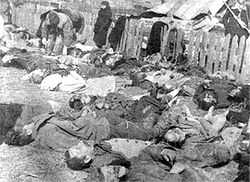Pavlivka
Pavlivka (Ukrainian: Павлівка, formerly Poryck, Polish: Poryck) is a town now located in northwestern Ukraine, in Volyn Oblast, near Volodymyr-Volynskyi, on the Luga river. For centuries, Poryck was property of several noble Polish families. The town is the birthplace of a Polish statesman Tadeusz Czacki (born 1765). On July 11, 1943, the Ukrainian Insurgent Army, supported by local peasantry murdered here more than 200 Polish civilians, who gathered in a local Roman Catholic church for a Sunday ceremony (see also Volhynian Genocide).
History
Poryck was first mentioned in the first half of the 15th century. In 1557 the town burned in a fire, and King Zygmunt August allowed its owner, Aleksander Porycki to exempt residents from taxes for the period of 10 years. Poryck belonged to several szlachta families, including the Koniecpolski family and the Czacki family. In 1806, Tadeusz Czacki built here two empire style palaces. Located at the lake, one palace housed a large library (the so-called Poryck Library), in which a number of Polish national treasures was kept. Also, Czacki had a rare collection of fine china. Second palace served as a family residence. In 1816, Poryck was visited by Julian Ursyn Niemcewicz, who described his stay here in his “Historic Travels”.
During the November Uprising, Poryck was one of targets of General Jozef Dwernicki’s raid over Volhynia, Podolia and Ukraine. On April 11, 1831, a Polish - Russian battle took place here. After a Polish victory, Dwernicki issued an appeal to the local residents, urging them to join the rebellion. In 1916, during World War One, the library was ransacked, and the china collection was destroyed, together with Czacki family archive. The residence was burned down, and what remained of the library was transported to Pulawy.
Poryck Massacre
In the interbellum period (1918–1939) it belonged to Poland, and was a town in Wołyń Voivodeship, inhabited by almost 2000 people, half of whom were Jewish and the remaining part mostly Polish and Ukrainian. The residents had previously lived peacefully together, and no ethnic conflicts had taken place there before.
On July 11, 1943, Ukrainian units of the Ukrainian Insurgent Army and OUN nationalist groups murdered Polish inhabitants of the town. Most people were killed during a ceremony in a local Roman Catholic church. The Ukrainians entered the church and threw grenades at the faithful, many of whom were women and children. Then they shot at them with machine guns and finally set fire on the church filled with people. Altogether 300 persons were brutally murdered. Later on, Ukrainian nationalists burned what remained of the Czacki palace. The town was captured by the Red Army on July 18, 1944.
On the 60th anniversary of the massacre, Presidents Aleksander Kwaśniewski of Poland and Leonid Kuchma of Ukraine unveiled a monument commemorating the event. Both presidents called for forgiveness and reconciliation, with Kuchma saying "In this place where Polish victims rest, on behalf of all Ukrainians who want peace and justice, I wish to express my deep sympathy to all the wronged Poles, all those who suffered as a result of this disaster. We issue a strong condemnation of the violence committed against the Polish civilian population."
Sources
- Zygmunt Stanski, Witold Stanski. "PORYCK miasteczko kresowe symbol tragedii Polakow na Wolyniu". Wydawnictwo A. Marszalek 2005. ISBN 978-83-7441-166-0.
- Wladyslaw Siemaszko, Ewa Siemaszko. "Ludobojstwo dokonane przez nacjonalistow ukrainskich na ludnosci polskiej Wolynia 1939-1945, Wydane przy pomocy finansowej Kancelarii Prezydenta Rzeczypospolitej Polskiej", Warszawa 2000. ISBN 83-87689-34-3
- Grzegorz Motyka. "Ukrainska partyzantka 1942-1960". Rytm Oficyna Wydawnicza. Warszawa. 2006. ISBN 83-7399-163-8.
External links
- (Polish) Poryck in the Geographical Dictionary of the Kingdom of Poland (1887)
- (Polish) Poryck in the Geographical Dictionary of the Kingdom of Poland (1902)
- A monument in Poryck
See also
- Massacres of Poles in Volhynia
- Krupki massacre
Coordinates: 50°37′10″N 24°27′44″E / 50.61944°N 24.46222°E
| ||||||||||||||||||||||||||||||||
